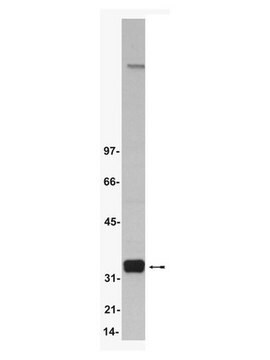MABE328
Anti-MeCP2 Antibody, clone 4H7
clone 4H7, from rat
Synonym(s):
Methyl-CpG-binding protein 2, MeCp-2 protein, MeCp2
About This Item
Recommended Products
biological source
rat
Quality Level
antibody form
purified immunoglobulin
antibody product type
primary antibodies
clone
4H7, monoclonal
species reactivity
mouse
species reactivity (predicted by homology)
rat (based on 100% sequence homology), porcine (based on 100% sequence homology)
technique(s)
ChIP: suitable
immunocytochemistry: suitable
immunohistochemistry: suitable
immunoprecipitation (IP): suitable
western blot: suitable
isotype
IgG2aκ
NCBI accession no.
UniProt accession no.
shipped in
wet ice
target post-translational modification
unmodified
Gene Information
mouse ... Mecp2(17257)
General description
Specificity
Immunogen
Application
Chromatin Immunoprecipitation Analysis: A representative lot was used by an an independent laboratory to detect MeCP2 in various, mouse WT, but not in MeCP2 knockout brain nuclear extracts (Jost, K. L., et al. (2011). PLoS ONE. 6(11):e26499).
Immunocytochemistry Analysis: A representative lot was used by an an independent laboratory to detect MeCP2 in various, GFP-meCP2 transfected C2C12 cells (Jost, K. L., et al. (2011). PLoS ONE. 6(11):e26499).
Immunohistochemistry Analysis: A representative lot was used by an an independent laboratory to detect MeCP2 in various, mouse WT, but not in MeCP2 hemizygous null brain tissue sections (Jost, K. L., et al. (2011). PLoS ONE. 6(11):e26499).
Epigenetics & Nuclear Function
Chromatin Biology
Quality
Western Blot Analysis: A 1:1,000 dilution of this antibody detected MeCP2 in 10 µg of mouse brain tissue nuclear extract.
Target description
Physical form
Storage and Stability
Analysis Note
Mouse brain tissue nuclear extract
Disclaimer
Not finding the right product?
Try our Product Selector Tool.
Storage Class Code
12 - Non Combustible Liquids
WGK
WGK 1
Flash Point(F)
Not applicable
Flash Point(C)
Not applicable
Regulatory Listings
Regulatory Listings are mainly provided for chemical products. Only limited information can be provided here for non-chemical products. No entry means none of the components are listed. It is the user’s obligation to ensure the safe and legal use of the product.
JAN Code
MABE328:
Certificates of Analysis (COA)
Search for Certificates of Analysis (COA) by entering the products Lot/Batch Number. Lot and Batch Numbers can be found on a product’s label following the words ‘Lot’ or ‘Batch’.
Already Own This Product?
Find documentation for the products that you have recently purchased in the Document Library.
Our team of scientists has experience in all areas of research including Life Science, Material Science, Chemical Synthesis, Chromatography, Analytical and many others.
Contact Technical Service






